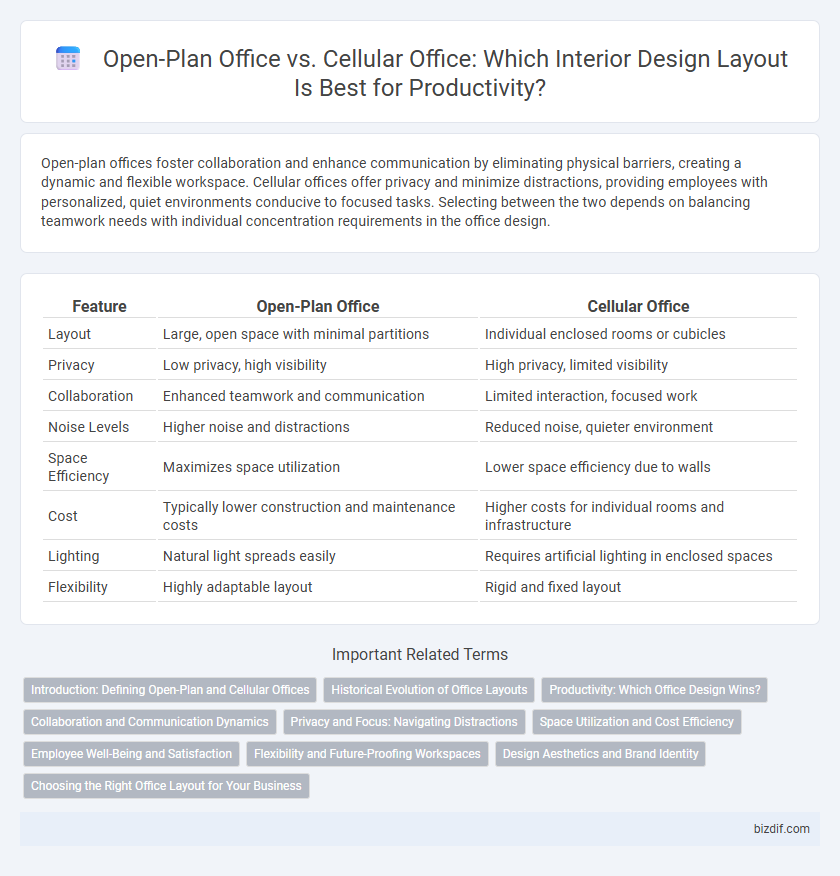Open-plan offices foster collaboration and enhance communication by eliminating physical barriers, creating a dynamic and flexible workspace. Cellular offices offer privacy and minimize distractions, providing employees with personalized, quiet environments conducive to focused tasks. Selecting between the two depends on balancing teamwork needs with individual concentration requirements in the office design.
Table of Comparison
| Feature | Open-Plan Office | Cellular Office |
|---|---|---|
| Layout | Large, open space with minimal partitions | Individual enclosed rooms or cubicles |
| Privacy | Low privacy, high visibility | High privacy, limited visibility |
| Collaboration | Enhanced teamwork and communication | Limited interaction, focused work |
| Noise Levels | Higher noise and distractions | Reduced noise, quieter environment |
| Space Efficiency | Maximizes space utilization | Lower space efficiency due to walls |
| Cost | Typically lower construction and maintenance costs | Higher costs for individual rooms and infrastructure |
| Lighting | Natural light spreads easily | Requires artificial lighting in enclosed spaces |
| Flexibility | Highly adaptable layout | Rigid and fixed layout |
Introduction: Defining Open-Plan and Cellular Offices
Open-plan offices feature large, unobstructed spaces with minimal partitions, promoting collaboration and communication among employees. Cellular offices consist of individual, enclosed rooms providing privacy and reduced noise, ideal for focused work. Understanding the spatial layout and functional goals of these office types is essential for optimizing employee productivity and workplace satisfaction.
Historical Evolution of Office Layouts
Open-plan offices emerged in the early 20th century, inspired by the need for flexibility and collaboration, contrasting with the cellular office layout that dominated the 19th century due to its emphasis on privacy and individual productivity. The transition from cellular offices to open plans accelerated during the post-World War II economic boom, driven by technological advancements and changing organizational cultures favoring teamwork. Recent trends show a hybrid approach incorporating both open and cellular elements to balance communication and focused work.
Productivity: Which Office Design Wins?
Open-plan offices foster collaboration and communication by removing physical barriers, which can enhance creativity but often increase distractions and noise, potentially reducing individual productivity. Cellular offices provide enclosed, private spaces that minimize interruptions and support focused work, leading to higher productivity for tasks requiring concentration. Organizations aiming to maximize productivity must balance the need for teamwork in open-plan layouts with the benefits of solitude offered by cellular offices.
Collaboration and Communication Dynamics
Open-plan offices enhance collaboration by removing physical barriers, fostering spontaneous interactions and quick communication among team members. Cellular offices, with enclosed spaces, minimize distractions but can hinder the flow of ideas and reduce face-to-face engagement. Choosing between these layouts depends on balancing the need for focused work and the frequency of collaborative activities in the organization.
Privacy and Focus: Navigating Distractions
Open-plan offices often face challenges in providing adequate privacy, as the lack of physical barriers can lead to increased noise and visual distractions, reducing employees' focus and productivity. Cellular offices offer enclosed spaces that enhance privacy and minimize interruptions, fostering a more concentrated work environment. Balancing collaboration needs with individual focus requirements is essential when choosing between open-plan and cellular office designs.
Space Utilization and Cost Efficiency
Open-plan offices maximize space utilization by minimizing partitions, allowing for flexible workstation layouts and accommodating more employees per square foot, which reduces overall rental expenses. Cellular offices, though offering privacy and noise control, typically require more square footage per person, leading to higher real estate and construction costs. Cost efficiency in open-plan designs often results from lower maintenance and utility expenses, while cellular offices incur added costs due to individualized climate control and partition materials.
Employee Well-Being and Satisfaction
Open-plan offices foster collaboration and improve communication but often lead to increased noise and reduced privacy, negatively impacting employee well-being and productivity. Cellular offices provide individual spaces that enhance focus, reduce distractions, and support mental health, promoting higher satisfaction among employees who value privacy. Balancing open and private areas through hybrid office design can optimize well-being and meet diverse employee preferences effectively.
Flexibility and Future-Proofing Workspaces
Open-plan offices offer greater flexibility by allowing easy reconfiguration of workspaces to accommodate changing team sizes and collaboration needs, supporting dynamic workflow adjustments. Cellular offices provide privacy and focused work environments but lack the adaptability to quickly evolve as organizational demands shift. Designing with modular furniture and movable partitions enhances future-proofing by enabling seamless transitions between open and segmented layouts.
Design Aesthetics and Brand Identity
Open-plan offices enhance design aesthetics through spacious layouts, natural light, and collaborative furniture, reflecting a modern and transparent brand identity. Cellular offices offer privacy with enclosed spaces and customizable interiors that embody professionalism and focused work ethics. The choice between these layouts directly influences spatial perception and reinforces core brand values within the workplace environment.
Choosing the Right Office Layout for Your Business
Selecting between open-plan and cellular office layouts depends on your business's need for collaboration versus privacy. Open-plan offices promote teamwork and communication by minimizing physical barriers while cellular offices offer noise control and individual focus through enclosed spaces. Assessing workflow, employee roles, and company culture ensures the optimal layout supports productivity and employee satisfaction.
Open-plan office vs Cellular office Infographic

 bizdif.com
bizdif.com